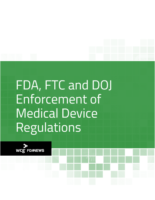
Home » CAPA, Complaint Procedures Top 2014 Form 483 Observations
CAPA, Complaint Procedures Top 2014 Form 483 Observations
Inadequate CAPA procedures led all other causes for Form 483s issued to devicemakers in fiscal 2014, while purchasing control issues jumped from sixth place to third in the FDA’s annual ranking of inspection observations.
The data are from the agency’s annual statistical report of 3,467 domestic and foreign device inspections that were scheduled from Oct. 1, 2013, through Sept. 30, 2014. During this period, the FDA issued 972 Form 483s to devicemakers, down from 1,099 in the prior fiscal year and 1,090 in 2012.
The top 10 observations in device 483s were:
- Lack of or inadequate procedures (cited in 360 forms, down from 378 in 2013);
- Lack of or inadequate complaint procedures (251, up from 245);
- Lack of or inadequate procedures for purchasing controls (129, up from 110);
- Lack of or inadequate process validation (122, down from 127);
- Lack of written MDR procedures (117, down from 124);
- Failure to adequately document corrective and preventive action activities and/or results (101, down from 133);
- Lack of or inadequate procedures for nonconforming product (100, up from 98);
- Lack of or inadequate procedures for design changes (95, up from 93);
- Lack of or inadequate procedures for quality audits (90, up from 73); and
- Investigation of device failures (68, down from 69).
The top 10 observations largely reflect those on the 2013 list, with some key differences — among them, the rise in purchasing control observations and the fact that observations on documentation of CAPA activities and/or results dropped from number three to number six.
Many of the observations reflect small companies struggling to follow overly complex SOPs, says John Avellanet, managing director and principal at the consulting firm Cerulean Associates. These companies would fare better if they identified the end goal of the FDA regulation and got there the best way that they could, he says. They can make SOPs very simple and straightforward using process maps and workflow diagrams.
Instead, some devicemakers purchase a 20- or 30-page SOP online and put a company logo on it, without having the manpower to follow the procedure, Avellanet said. “I have heard this from numerous FDA investigators: It is better for you to flowchart out a process that you actually do and will follow on a cocktail napkin and use that as your procedure than to write some 30-page SOP that looks great on paper but nobody follows. I think that’s ultimately what happens a lot of the time.”
Avellanet also tells clients that each SOP should generate some form of documentation, whether that be a record, form, checklist, template, draft letter, batch record or other document.
According to Avellanet, the increase in purchasing control issues this year was likely due to devicemakers relying solely on a purchase order instead of negotiating a quality agreement with certain suppliers. This can be challenging, he acknowledges, as many suppliers won’t take the time to negotiate these agreements with smaller clients.
Meanwhile, a common mistake smaller companies make with complaint procedures is having the office manager review complaints with a customer service focus and not follow a decision tree for reporting decisions to the FDA. For process validation, many devicemakers follow the recent FDA guidance for pharmaceutical companies, but have not adequately documented the justification for that decision, he says.
Prepare yourself for these leading causes of 483s and stay up to date with the latest FDA news regarding inspections by subscribing to FDAnews Inspection Insider today!
Upcoming Events
-
23May
-
30May
-
13Jun
-
20Jun
-
21Oct
